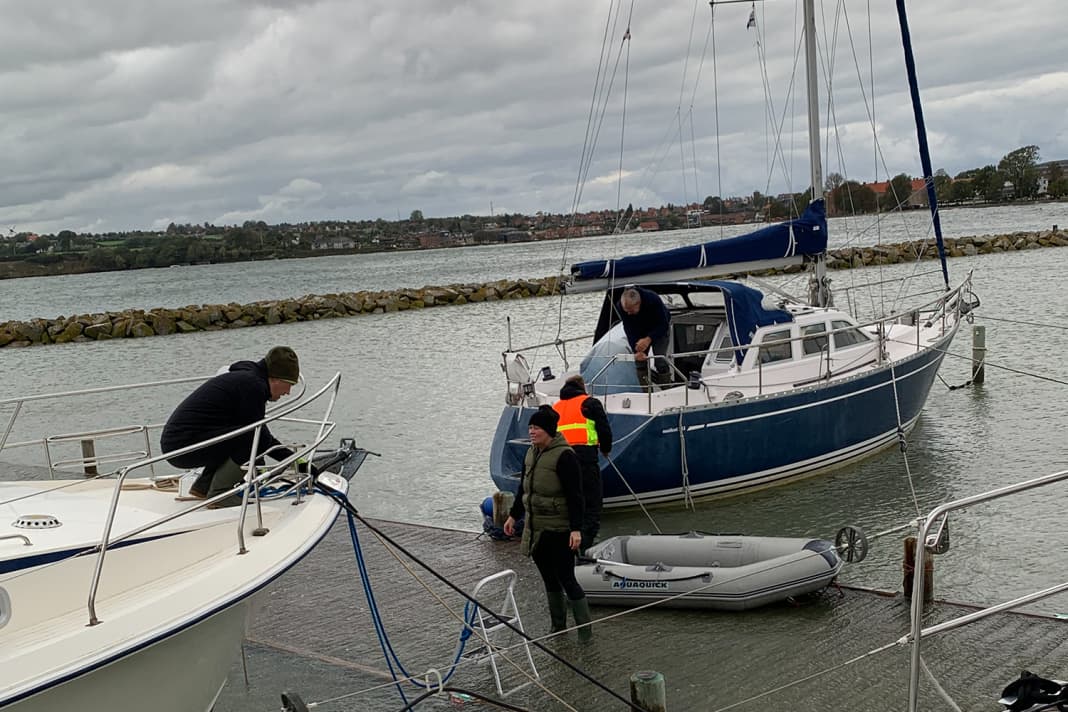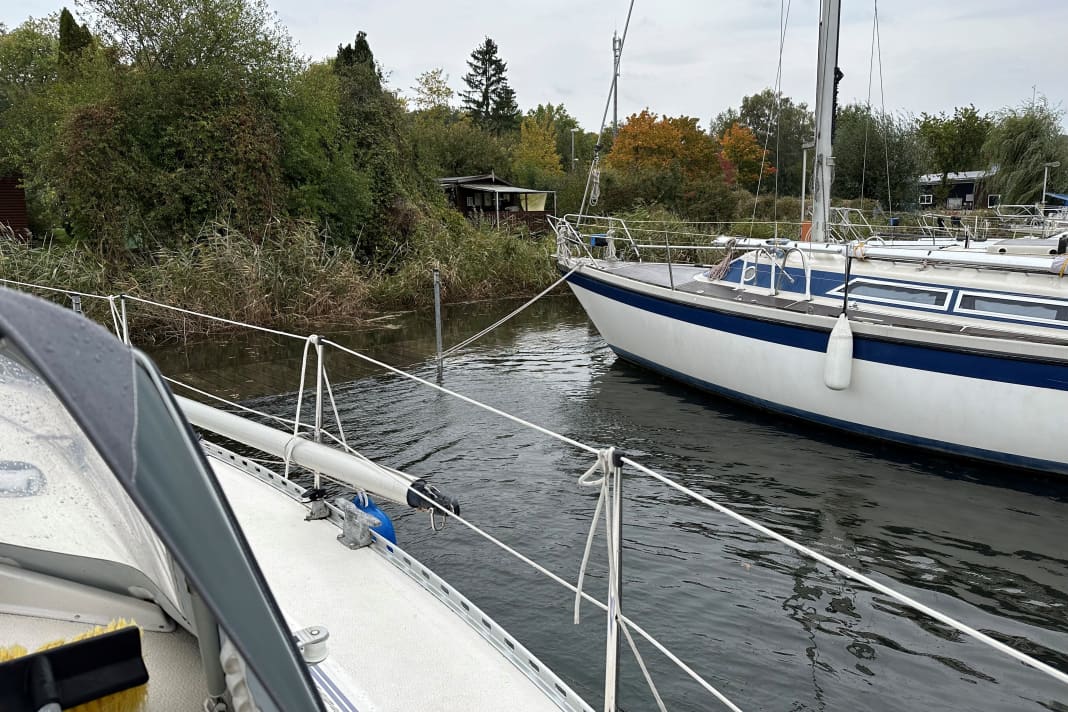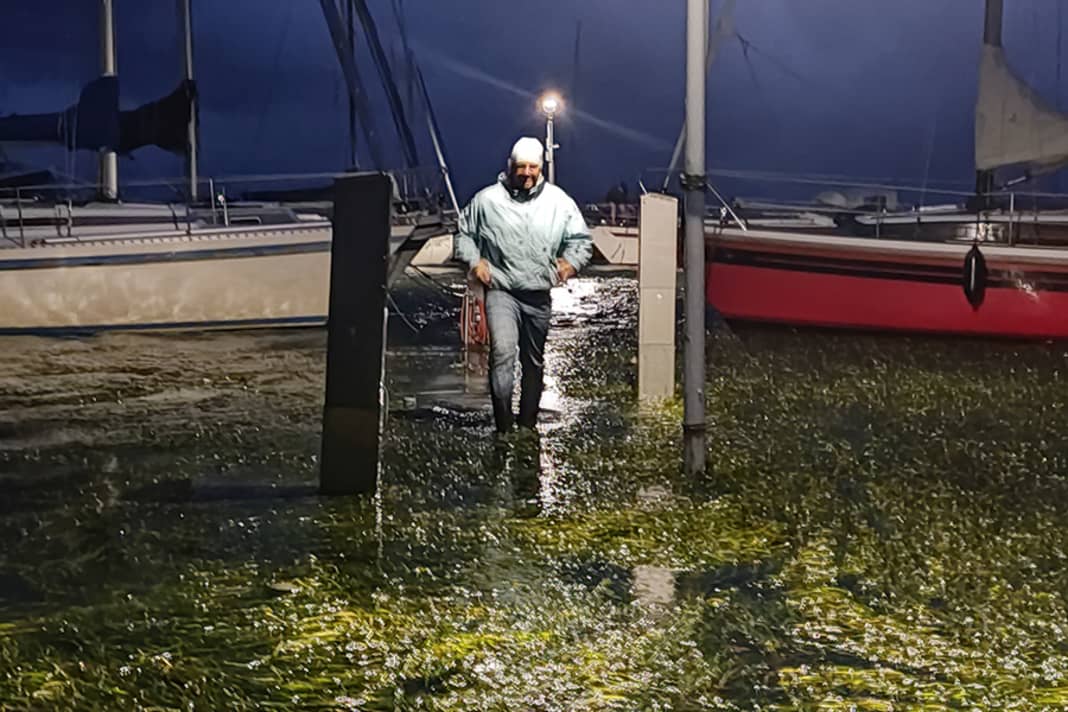Baltic Sea storm surge: What it's like on board





Sønderborg: lots of water, but no storm yet
Three personal lessons can be learnt from the first 24 hours of extreme high water: Square mooring lines creak much more than conventional ones, plastic stakes allow lines to slip upwards more easily, and you actually need waders on board. Here in Sønderborg, the water has risen steadily; since Thursday evening it has been around 40 centimetres above the jetties, the Baltic Sea storm surge is here.
Nine lines on five cleats
I laid a second fore line from the leeward cleat to windward to the jetty and there to another point, plus a spring from the centre cleat. I was able to throw out a second stern line to the already used pole. The pole is new, but made of plastic, and it wobbles alarmingly. I therefore asked the passing harbour master to attach another stern line to the next windward pole. A good idea, as it turned out later. Our boat is now moored on one double and two single fore lines on two cleats, one spring and four aft lines on two cleats and two poles. Should be enough. The easterly wind hits the boat from the port side, it jerks, creaks, wobbles and heels. There is some wave in the harbour. The Baltic storm surge is here, but the big wind has so far failed to materialise here in the cover. The wind gauge on the jetty is talking about gusts of just under 8 Beaufort.
Two aft lines slip off the pole
The harbour master has switched off the power at the jetty. The water has risen further and now I can't get ashore easily. It's like anchoring in bad conditions. The night was okay, all the lines, cleats and stakes held. It happens before first light: the double stern lines slip off the plastic pole. Oilskin, lifejacket, safety line, knife, gloves. Switch on the engine, slacken off the fore lines, loosen the spring a little, open the stern flap, open the throttle a little and head for the pile. As the wave approaches, try to attach the lines to the pole again with the bowline running, push them down with the boat hook and maintain the pull. This will eventually work.
I leave more tension on the lines that are at risk of slipping and less on the wooden pole, where the lines hold just as well. I'll have to recharge the batteries with the engine later. There's still some food on board. The expired rice chicken, a leftover from a YACHT test of freeze-dried bagged food, wasn't that great. Later, my neighbour Frank will come by with an inflatable boat. At least I'll have a lift if things get really bad. There's supposed to be more wind in addition to the Baltic Sea storm surge - and another 40 centimetres of water.
Fridtjof Gunkel
Bad Schwartau: only with dinghy or waders





I have never seen the water level in our club harbour as high as it is expected to rise due to the Baltic Sea storm surge. I'm a little worried about whether the mooring lines are in the right place. The Baltic Sea storm surge is also expected to be accompanied by squalls. So early on Thursday morning, I decide without further ado to set up my workplace on board. I quickly put the essentials, sea boots, laptop and oilskins in the car and set off.
When we arrive at the boat, the water is already close to the jetty. The bow is already very high above the jetty boards, not easy to climb on board. We check the lines, deploy two additional mooring lines to be on the safe side and then take a walk round the jetties to check on the other boats and their mooring lines. All good. The workplace is set up in a somewhat cramped space at the chart table. As I've already laid the mast and had to make way for the saloon table, the boat isn't quite as cosy as it was a week ago.
Coffee is still there, but unfortunately no milk. I didn't take any food with me in the rush. I hoped there would be something on board. In fact, there are 5-minute terrines, a bag of crisps and chocolate biscuits. The coffee also tastes black.
Night watch on board
From 2 p.m., the water rises over the jetty. From now on, the sea boots are used, which have only been worn once this season and then only against the cold. Now I realise that the right boot is no longer waterproof. Luckily I still have dry socks and shoes in the car. The water level is now only rising slowly, all the boats are well moored. Photos and a reassuring summary of the tour are sent to the club WhatsApp group.
From late afternoon onwards, other owners come to check on the boats. Some want to stay overnight. The water is expected to rise further in the evening, so you can't get to the boat without a dinghy or waders. In addition, the ascent over the bow becomes too steep at some point. My dinghy is already at home. So I decide to head home again. From now on, despite making sure that all the lines are in place, I'm a little worried about new news in the group. On Friday after work, I'll definitely go again. This time with the dinghy in the boot.
Michael Rinck
Strande: torn out bollards




In Strande on the Kiel Outer Fjord, many yachts are still in the water on Wednesday evening as they prepare for the predicted Baltic storm surge. The local yacht clubs have already accommodated the majority of their fleets in the neighbouring winter storage area, but not all of them. The mood of the owners, who begin to move their yachts to the more sheltered berths on site, is initially still dominated by the feeling of experiencing something exciting. Storm in the harbour? You can deal with that. Good craftsmanship is required, but this is eventually mastered. People swap ideas in small groups, make sure they have help and a watchful eye in case something happens.
Roaring noises below deck
Then the water level slowly begins to rise. Very slowly at first, but by Thursday the first jetties were already under water. The wind had kept to the forecast during the night. Strande with an easterly wind is one of those things. Even if it's just blowing strongly. Now it makes the masts, which are still standing, make a roaring noise. Especially below deck, where I stay to be there if something happens.
Like on the neighbouring jetty, where the first bollards were ripped out of the concrete jetty on Thursday evening. I get the pictures sent to my mobile phone, so I don't move off the boat unless I have to. It's on a floating jetty, but the path from the shore to it is already so far under water that it reaches the top of my sea boots.
As darkness falls, the blue flickering lights of the volunteer fire brigade create a dignified atmosphere; nobody can say what they are up to, but it looks spooky. The faces of the few people on the footbridges look tense, there is no sign of any sense of adventure. A few undaunted people are still hauling up their boats, as the storm is expected to kick up a notch during the night, as is the Baltic storm surge.
The home is no longer cosy
It does. On Friday morning, the ship is shaken so much in the gusts that sleep is out of the question. It has also become cold, and the harbour masters have switched off the power completely as a precaution. The water is now almost up to the promenade, so a pair of waders would be needed to get ashore dry. I don't have them, so I watch the spectacle once again from my island, which no longer reminds me of the cosy home from the sailing summer.
I look over to jetty 1, where a single mast lies at a 45-degree angle. Permanently. The pier is no longer recognisable, the sea simply washes over it. Also permanent. Seagrass meadows form picturesque green patches in the white foam of the harbour water. I have deployed several mooring lines to windward, including a shock absorber, and my bollards are still holding. It's still enough, at least for me. The readings at the Kiel lighthouse have been averaging 45 knots for 12 hours now. According to the Beaufort scale, that's the kind of wind that sends garden furniture flying to the neighbours. Hopefully none will land on my deck. It's supposed to pick up a bit more in the coming night.
Lasse Johannsen

